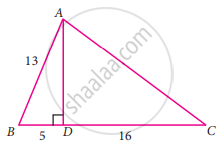Advertisements
Advertisements
प्रश्न
If sinA = `(3)/(5)`, find cosA and tanA.
उत्तर
sinA = `(3)/(5) = "Perpendicular"/"Hypotenuse"`
By Pythagoras theorem, we have
⇒ (Hypotenuse)2 = (Perpendicular)2 + (Base)2
⇒ (Base)2 = (Hypotenuse)2 - (Perpendicular)2
⇒ (Base) = `sqrt(("Hypotenuse")^2 - ("Perpendicular")^2`
⇒ (Base)
= `sqrt(5^2 - 3^2)`
= `sqrt(25 - 9)`
= `sqrt(16)`
= 4
cos A = `"Base"/"Hypotenuse" = (4)/(5)`
tan A = `"Perpendicular"/"Base" = (3)/(4)`.
APPEARS IN
संबंधित प्रश्न
If ∠A and ∠P are acute angles such that tan A = tan P, then show that ∠A = ∠P.
In a ΔABC, right angled at A, if tan C = `sqrt3` , find the value of sin B cos C + cos B sin C.
If A = B = 60°. Verify `tan (A - B) = (tan A - tan B)/(1 + tan tan B)`
In the figure of ΔPQR , ∠P = θ° and ∠R =∅° find
(i) `sqrt(X +1) cot ∅`
(ii)`sqrt( x^3 + x ^2) tantheta`
(iii) cos θ

Verify each of the following:
(i)`sin 60^0 cos 30^0-cos 60^0 sin 30^0`
If sin A + cosec A = 2;
Find the value of sin2 A + cosec2 A.
Given : 5 cos A - 12 sin A = 0; evaluate:
`(sin "A"+cos"A")/(2 cos"A"– sin"A")`
In each of the following, one trigonometric ratio is given. Find the values of the other trigonometric.
sinB = `sqrt(3)/(2)`
From the given figure, find the values of tan C
If sin θ = `"a"/sqrt("a"^2 + "b"^2)`, then show that b sin θ = a cos θ
